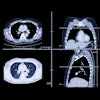The Alberta Stroke Program Early CT Score (ASPECTS) is a 10-point scale that rates the presence or absence of ischemia in 10 regions of the brain. Paired with noncontrast CT when a patient presents with stroke symptoms, ASPECTS has been shown to be an effective predictor of which patients will benefit from thrombolytic therapy.
In a 2003 study, for example, ischemic stroke patients with a baseline ASPECTS greater than 7 were three times more likely to have an independent functional outcome with thrombolysis compared with a control group, whereas patients with a baseline ASPECTS less than 7 were less likely to benefit. Earlier studies showed ASPECTS result to be reproducible at varying levels of observer expertise, predicting functional outcomes as well as the likelihood of symptomatic intracerebral hemorrhage.
Last year in a study of patients with anterior circulation stroke, higher ASPECTS (6-10) predicted outcomes linearly, while lower scores (0-5) predicted outcomes in a poorly defined pattern. At the same time, ASPECTS discriminated individual outcomes weakly, and the authors cautioned that clinicians should not estimate prognosis using ASPECTS alone unless early ischemic changes are extensive (Neurology, August 8 2006, Vol. 67:3, pp. 516-518).
These days a patient's first scan at admission could well be perfusion CT, which provides additional benefits over noncontrast CT in its ability to distinguish salvageable tissue.
In perfusion imaging, the decrease in cerebral blood volume (CBV) is known to correlate with final infarct size and with diffusion-weighted imaging (DWI) MR findings, while mean transit time (MTT) and cerebral blood flow (CBF) represent ischemic tissue at risk, explained Dr. Jeff Mandelcorn from the University of Toronto in Ontario.
The ASPECTS "first of all discriminates outcome from middle cerebral artery (MCA) infarcts in a quick and reliable fashion," Mandelcorn said in a presentation at the 2006 RSNA meeting in Chicago. "It emphasizes clinically important regions of brain, and offers thresholds for discriminating treatment with thrombolysis."
Still, the appropriate role ASPECTS in CT perfusion imaging is unclear. "We know that the extent of decreased cerebral blood volume correlates with perfusion imaging MR findings," he said. "And MTT and CBF represent the ischemic tissue at risk, so once you subtract the CBF or MTT, depending, from the CBV, this gives your penumbra or salvageable tissue."
Because perfusion CT can identify potentially salvageable tissue, different thresholds in perfusion CT may also be superior in predicting clinical and radiological outcomes, he said.
Could ASPECTS scoring work better with perfusion imaging? "The purpose of this study was to determine whether aspects assessment was superior to noncontrast CT, both in predicting clinical and radiological outcomes," Mandelcorn said.
The researchers examined 36 consecutive patients (18 women and 18 men) who presented with stroke-like symptoms within three hours of onset (mean 154 minutes); all underwent CT perfusion imaging at presentation, were treated with thrombolysis, and followed up at five to seven days with noncontrast CT.
Three neuroradiologists reviewed the presentation noncontrast and perfusion CT studies in a random fashion, calculating ASPECTS at five to seven days. A 90-day modified Rankin score compared the ASPECTS with radiological and clinical reference standards, analyzing data with SPSS (Chicago) software.
The researchers correlated ASPECTS for noncontrast CT and perfusion CT parameters for both clinical and radiological outcomes, determining their significance by Fischer's exact test. Receiver operating characteristic (ROC) curves were used to calculate the optimal thresholds for determining outcome.
Among recanalization patients, "the mean CBV and noncontrast CT scores were not significantly different from the final ASPECTS on noncontrast scan seven days later, whereas in the nonrecanalization group, the CBF and MTT scores most closely approximated that final noncontrast CT score," Mandelcorn said.
CBV and noncontrast CT had equivalent correlation with the final noncontrast CT exams (0.77), compared with MTT or CBF (0.63 and 0.62, respectively). CBV accuracy was higher than noncontrast CT, and all perfusion CT parameters discriminated both radiological and clinical outcomes significantly, Mandelcorn said.
The researchers also established dichotomized thresholds that offered the best sensitivity, specificity, and accuracy above and below which clinical outcomes were good or bad. Cerebral blood volume 8 or greater was the only acute parameter that was a statistically significant predictor of good clinical outcome correlating with the 24-hour National Institutes of Health stroke score (NIHSS) score.
"Only CBV predicted rapid clinical improvement," Mandelcorn said. "CBV and ASPECTS were higher in patients who did well and lower in patients who did poorly." The other strong predictor was the final noncontrast CT at seven days, too late to be actionable in the acute setting.
The noncontrast CT and CBV correlation with the final outcome was better in the recanalization group, while the reverse was true in patients who did not recanalize, and there was no significant difference in sensitivity between noncontrast CT, CBF, and MTT in discriminating outcomes, Mandelcorn said.
The ROC thresholds for CBV and CBF/MTT differed from noncontrast CT: CBF and MTT accuracy equaled the final infarct size with lower sensitivity. The intraobserver agreement for CBV was slightly higher than noncontrast CT. But the change in NIHSS had the greatest predictive value for clinical outcomes.
ASPECT thresholds applied to perfusion CT increase the accuracy for predicting radiological and clinical outcomes over noncontrast CT, and the ability of perfusion CT to distinguish salvageable tissue suggests an added benefit over noncontrast CT in patient selection for thrombolysis, Mandelcorn concluded.
"ASPECTS scoring of CBV data provides additional clinical prognostic information not available on noncontrast CT, and intraobserver agreement on perfusion maps was higher versus noncontrast CT," he said. "Perfusion imaging offers an accurate and reliable method of predicting radiologic and clinical outcomes. This easy-to-use scale may offer additional benefits for selecting viable patients for thrombolysis."
By Eric Barnes
AuntMinnie.com staff writer
February 21, 2007
Related Reading
Mechanical clot removal can often improve stroke outcomes, February 13, 2007
Device-assisted thrombolysis shortens DVT treatment time, April 5, 2005
Advanced MR clarifies nexus between white matter and cerebrovascular disease, February 9, 2007
Relative threshold method correlates CT, MRI stroke infarct assessment, February 9, 2007
Copyright © 2007 AuntMinnie.com




















